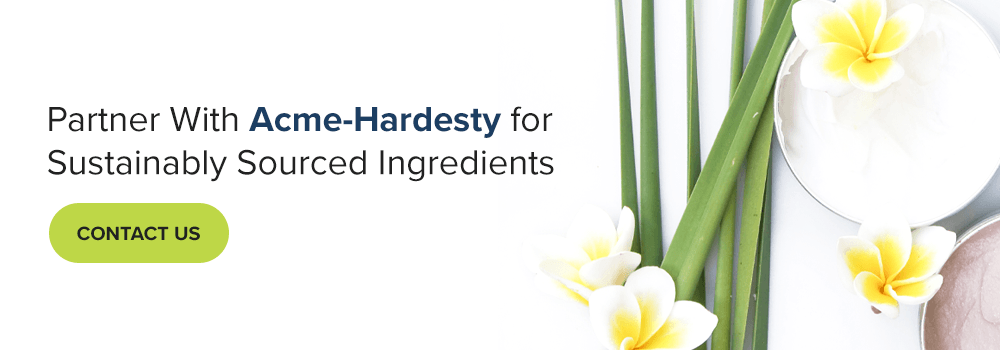The Rising Demand for Esters and Sustainable Ingredients in the Personal Care Market
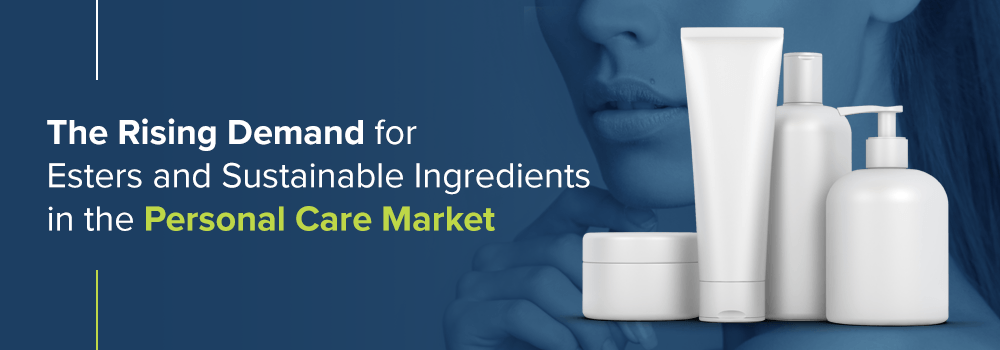
The personal care market is vast and is growing all the time. The personal care space encompasses everything from skincare and cosmetics to hair care, fragrances and more. Products that enhance the health and appearance of our bodies, from head to toe, will seemingly never go out of style. After all, who doesn’t want to look and feel their best?
The global market size of the personal care space is projected to have a compound annual growth rate (CAGR) of 5.9 percent over the next several years, resulting in the market reaching a value of $716.6 billion in U.S. dollars by 2025. According to a 2018 research report, one of the major factors driving the growth of the market is the growing demand for natural and organic personal care products.
One particular type of ingredient that personal care product manufacturers should pay attention to, in order to capitalize on current trends and elevate the quality of personal care products, is esters. Esters are fatty acids that are natural, sustainable and come with a whole host of benefits. They can enhance the feel and performance of other ingredients and come with powerful benefits of their own.
In this post, we’ll learn more about esters and their role in the future of the personal care market. As we’ll see, seeking out sustainable ingredients for personal care manufacturing is a worthwhile cause.
What Are Esters and How Are They Used?
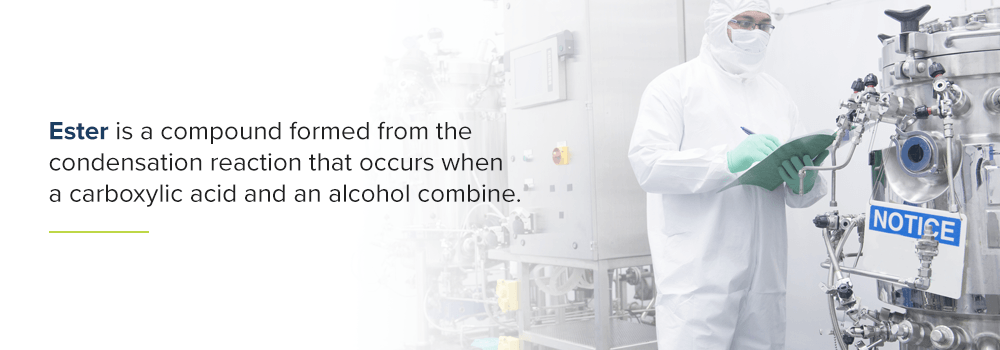
Esters fall within the category of oleochemicals, meaning they are naturally-derived chemicals rather than synthetic, potentially harmful ones. An ester is a compound formed from the condensation reaction that occurs when a carboxylic acid and an alcohol combine. The exact combination of the type of alcohol and the type of carboxylic acid will determine which ester is produced.
There is a wide array of possibilities. For example, when the acid in the combination is a fatty acid, the result is a fatty acid ester. We can get more specific by looking at the exact makeup of certain esters. For instance, the ester Triolein is derived from glycerol and three units of oleic acid.
Esters can be found all throughout the natural world. They are known for producing a range of pleasant fragrances and flavors. They occur naturally in many foods, such as fruit, and in alcoholic beverages. Triesters, molecules that contain three ester groups, occur in nature as oils and fats.
While chemists may be concerned with exactly how these compounds are formed and their molecular makeup, manufacturers tend to be more concerned with the practical applications of esters.
The food industry has long understood the value of esters and has used, and continues to use, them in a variety of products. Esters can help enhance flavor and are especially useful as an emulsifier. Emulsifiers are surfactants, meaning they reduce surface tension between two immiscible liquids, such as water and oil, thereby stabilizing the mixture. Esters can also improve the texture of many food products, including low-fat liquids which may lack enough viscosity without the standard amount of fat.
While esters have been primarily used in the food industry, they are also useful in many other arenas, including personal care, pharmaceuticals, agriculture, metal treatment and lubricants. The diversity of these industries is a testament to just how useful esters can be.
In particular, in recent years, there has been a rising demand for esters used in everyday life through the personal care space, where they can stand in for traditional petroleum ingredients. In personal care products, esters can function as a(n):
- Emollient: Esters can be extremely beneficial to skin. They are emollients, meaning they hydrate, soften and smooth the surface of skin. Lotions and creams intended to improve the texture of skin rely on emollients as their active ingredients. Unlike other types of emollients, esters don’t leave an oily residue on the skin, which gives them a special advantage.
- Solvent: Esters can also function as a solvent. Solvents dissolve ingredients so they can mix together and work properly. Many personal care products, including powders, lotions and shaving creams, contain solvents to achieve the proper consistency.
- Thickening agent: Esters also function as thickening agents in cosmetics. Thickeners enhance the consistency, viscosity and volume of lotions, creams, conditioners and other personal care products.
- Surfactant: As discussed above, surfactants allow liquids that would otherwise remain separate from one another to mix and remain in suspension. Many personal care products contain both lipids and water, so these products need an emulsifier to stabilize the mixture.
- Fragrance: Esters are popular among perfumers and personal care product manufacturers for their naturally pleasant scents. For example, Propyl Ethonoate smells like fresh pairs, Pentyl Nonoate smells like roses, and Propyl Octanoate smells like coconut.
With so many benefits, it shouldn’t come as a surprise that personal care product manufacturers are becoming increasingly interested in incorporating esters into their products. This rising demand for esters is evident in the growth of the market.
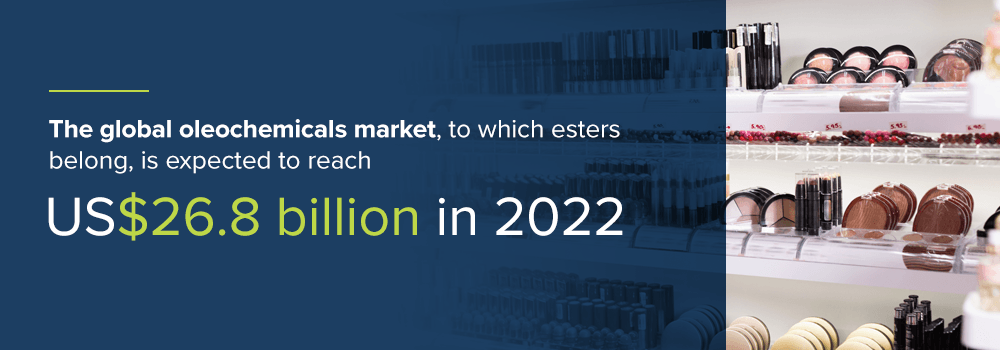
The global oleochemicals market, to which esters belong, is expected to reach $26.8 billion in U.S. dollars in 2022. Transparency Market Research (TMR) expects the global market for fatty acid esters alone to rise to $2.24 billion by the end of 2020. The market for oleochemicals, as we saw, depends on many different industries, but it has been growing in part due to the rising demand from the personal care industry. In particular, the personal care industry is interested in fatty acid esters, especially Isopropyl Palmitate, the ester formed from Isopropyl Alcohol and Palmitic Acid.
The Growing Importance of Natural Ingredients in Personal Care Products
The personal care market is discovering that, from body lotions and creams to infant cleansing products and hair care products, esters can improve fragrance, texture and performance. You can typically achieve these same effects using synthetic chemicals and ingredients, but these ingredients may have toxic properties. In contrast, esters in personal care are dermatologically safe. They are also biodegradable, making them an environmentally sustainable ingredient.
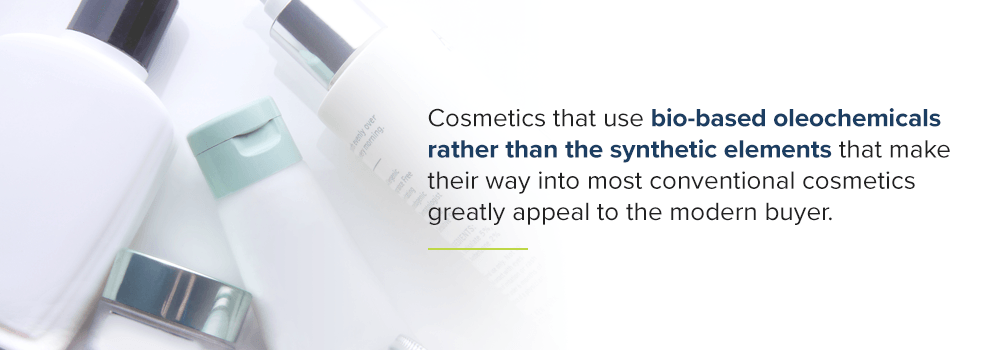
Cosmetics that use bio-based oleochemicals rather than the synthetic elements that make their way into most conventional cosmetics greatly appeal to the modern buyer. A 2015 study found that the majority of global consumers are willing to pay more for brands that are committed to sustainability. This preference for so-called “green” chemical ingredients and products is especially pronounced among Millennials.
Across all age groups, the desire for green products increased notably from 2014 to 2015, and this trend is continuing as more mainstream consumers become aware of the value of natural, sustainable products. It’s clear that the push for sustainable beauty isn’t just a passing fad — it’s part of a growing awareness of the potential damage to the environment and to a person’s health that products containing synthetic, toxic ingredients can have.
Today’s consumer is more likely than previous generations to take the time to read the ingredients on the label of a personal care product. When choosing a daily moisturizing cream, for example, many consumers will intentionally look for one with sustainable skin care ingredients. An informed consumer who is committed to buying bio-based products will know which ingredients to look for, both good and bad, on an ingredient list.
In light of this significant trend, it’s no wonder that a 2018 market research report for the personal care industry noted that, across all categories of cosmetics and personal care products, many new products were launched that capitalized on the use of botanical and natural ingredients. Some longtime giants in the market are also beginning to embrace the move toward sustainability and natural personal care ingredients.
What Are the Top Esters in Demand in the Personal Care Market?

We know that esters offer some valuable benefits in general, but not all esters are exactly the same, though many share similar properties. Since esters include a whole group of compounds, let’s take a moment to look at which esters, in particular, are in especially high demand throughout the personal care market today:
1. Decyl Oleate
Decyl Oleate’s chemical name is 9-Octadecenoic acid (Z)-, decyl ester. It is made from straight-chained decyl alcohol and oleic acid, a fatty acid naturally derived from plant and animal sources, such as avocados, canola oil or lard. This ester is commonly used in all sorts of personal care products, including skin care products, hair care products and makeup. This type of ester lubricates skin without leaving a tacky or greasy feel. One of the primary benefits of Decyl Oleate in personal care is that it aids in both the application and removal of makeup.
2. Triethyl Citrate
Triethyl Citrate is a triester of ethyl alcohol and citric acid that appears as a colorless, odorless liquid. Citric acid is a weak acid that naturally occurs in citrus fruits and other foods and plants and is used to preserve and flavor foods and beverages. In personal care, Triethyl Citrate is used in infant care products, bath products, creams and lotions, cosmetic sprays and many other types of personal care products. It is also an active ingredient in many chemical skin peels.
3. C12-15 Alkyl Benzoate
C12-15 Alkyl Benzoate is a liquid that contains benzoic acid and alcohols that have anywhere from a 12 to 15 carbon chain length. This ester has a wide range of applications. C12-15 Alkyl Benzoate works as an exceptionally effective emollient. It’s useful in skin care products, makeup, suntan products, bath products, shaving products and hair care products. One thing that sets Alkyl Benzoate apart is it has a lower molecular weight than most esters used in personal care.
4. Triolein
Triolein is a Glyceryl Triester. Like other esters, it is used to increase the viscosity of products and as a solvent, making it useful in a wide array of personal care products. It also has a high emolliency, meaning it can effectively rehydrate and soften skin. Personal care products that may use Triolein include creams and lotions, hair conditioners, makeup, deodorants, suntan and sunscreen products and skin care products.
5. Isopropyl Palmitate (IPP)
Isopropyl Palmitate is a liquid that is nearly colorless and odorless. Its chemical name is Hexadecanoic Acid, Isopropyl Ester. It can lubricate skin and thicken products. It is also a binder, meaning it enhances the way other ingredients come together. A compounded dry powder mixture of solids with IPP added to it will hold together when it’s compressed into a cake and will stay together when in use.
6. Isopropyl Myristate (IPM)
Isopropyl Myristate is an ester of Myristic Acid and Isopropanol. Myristic Acid is a fatty acid that is naturally in many foods. IPM’s chemical name is Tetradecanoic Acid, Isopropyl Ester. It is a colorless liquid with a faint odor. Like the other esters mentioned, IPM is an effective emollient and thickener. It is used in skin care products, shaving products, makeup, soaps and detergents, hair care products and nail care products.
Sensorial Trends in the Personal Care Market
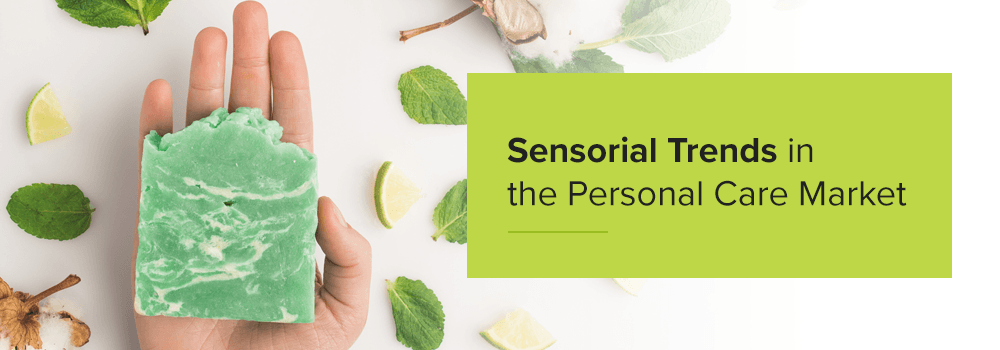
Responsible sourcing and effective performance are certainly key, but you also have to consider some other factors. One of the most critical trends to be aware of in the personal care ingredients market is the increased concern over sensorial factors. When consumers are choosing personal care products, sensory perception matters. The way a product looks, the way it smells and the way it feels are all significant.
The average consumer now cares more about the overall sensory profile of their products than ever before. Consumers today want their products to deliver a luxurious sensory experience that was once only associated with more high-end brands.
A Datamonitor report found that over a third of women and over a quarter of men identified sensory benefits as a factor that has a high degree of influence over their buying decisions when it comes to personal care products. This emphasizes the fact that sensory benefits are not a bonus to many people but a requirement.
It may happen subconsciously, but consumers use the sensory information they gather about a product to set up their expectations for its performance, and these expectations will also color the way they perceive the product’s actual effectiveness, even after using it for some time. The exception to this is if the product significantly under- or over-performs compared to their expectation.

This makes sense when you consider the fact that it usually takes time for a product such as a cream or lotion to have a real effect on skin. It’s difficult for people to accurately compare their skin today to their skin a week or two weeks ago when they started using a product. In contrast, it’s easy to compare the way their skin feels from one moment to the next.
The second a consumer pumps lotion into their hand, they form an instant impression. As they rub the lotion into their skin, they gather more information and further form their impression of the product. Even if the product is meant for functionality rather than fragrance, they immediately consider the fragrance. Is it pleasant or unpleasant? Too strong? Too weak?
They consider the texture. Is it easy to rub in? Is it thick enough or too thin? Thickness suggests to a consumer that the product is more potent and effective, rather than being diluted. Finally, they consider how it feels on their skin. Does it absorb into skin effectively, or does it leave a greasy residue that may clog pores?
All of these aspects of a product will determine a consumer’s impression of it, regardless of how well the product delivers on its intended purpose.
Sensory Benefits of Esters
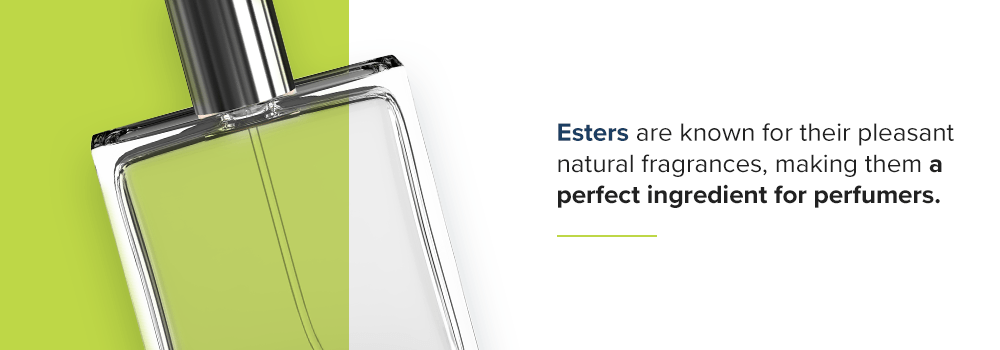
This trend is one of the reasons esters are in such high demand. At every stage of a consumer’s sensory experience with a product, esters can have a positive effect.
- Esters are known for their pleasant natural fragrances, making them a perfect ingredient for perfumers. They can also help elevate the scent of a product focused on functionality, such as a hair conditioner or face cream.
- Using esters as a thickener results in a product that is more viscous rather than runny, which immediately suggests to consumers that the product is high-end and effective.
- Emulsifiers and silicones can enhance the feel of a product on skin, but so can natural alternatives to petroleum-based products, such as esters. Esters have the major advantage of not leaving a greasy residue on a person’s skin, which drives home a favorable impression of the product.
As with the movement toward natural, eco-friendly products with sustainable ingredients, the rising importance of sensory aspects of a product should get manufacturers’ attention. If manufacturers of personal care products want the edge they need to succeed in such a competitive industry, they must be aware of significant trends in the personal care space.
Your product could be extremely effective, but if the smell or some aspect of the texture is off, then consumers may never even give it a chance. Before your product can prove its efficacy, it needs to pass the sensory test.
To put it simply, a product that feels good on skin or hair, smells nice and doesn’t leave an oily residue is more likely to be a winner with consumers compared to a product that is just as effective at moisturizing skin or cleansing hair but doesn’t deliver the same premium sensory experience.
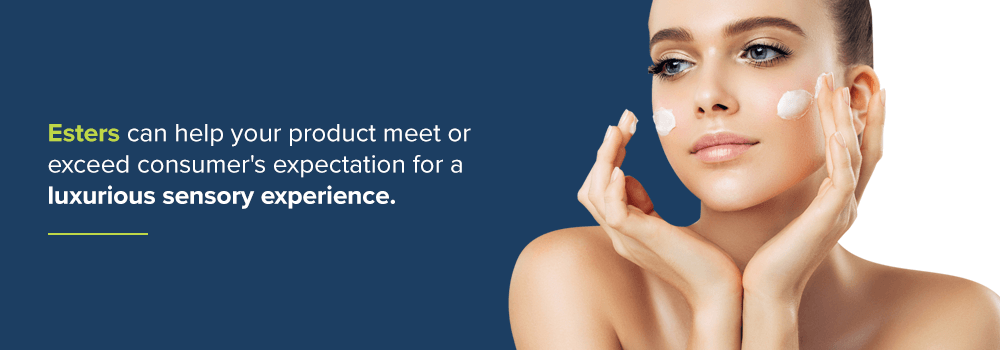
As we’ve seen, esters can help your product meet or exceed consumer’s expectations for a luxurious sensory experience. Once consumers are pleased with their initial experience applying the product, they can focus on its efficacy in cleansing, moisturizing, tightening or whatever the beauty or skincare product is intended to do.
Partner With Acme-Hardesty for Sustainably Sourced Ingredients
To enhance your products in many ways and make them more eco-friendly, consider replacing petroleum-based ingredients and other potentially toxic and unsustainable ingredients you currently use in your products with natural ingredients such as esters.
For the highest-quality oleochemicals, turn to a producer and supplier of esters and surfactants you can trust. It’s not enough to find the right ingredients. You want to source them from a supplier who shares your commitment to sustainability and quality. After all, your products are only as good as the ingredients they contain.
Over the course of over 80 years, Acme-Hardesty has developed a reputation for innovation, growth and dependability as a trusted supplier of industrial chemicals, including esters. In all of our sourcing, we are committed to global sustainability. We demonstrate this commitment through our membership in various round tables and organizations that are taking action to raise the standards for environmental stewardship across the chemical industry. Acme-Hardesty is guided by our convictions and driven by a passion to serve our customers better, each and every day.
For specialty care products that will elevate the overall quality of your products and make them more eco-friendly, turn to Acme-Hardesty, your trusted ester supplier and partner for bio-based chemical ingredients. Browse through our products, and contact Acme-Hardesty today for a free quote on esters, surfactants and other sustainable ingredients that will bring your personal care products to a new level.

